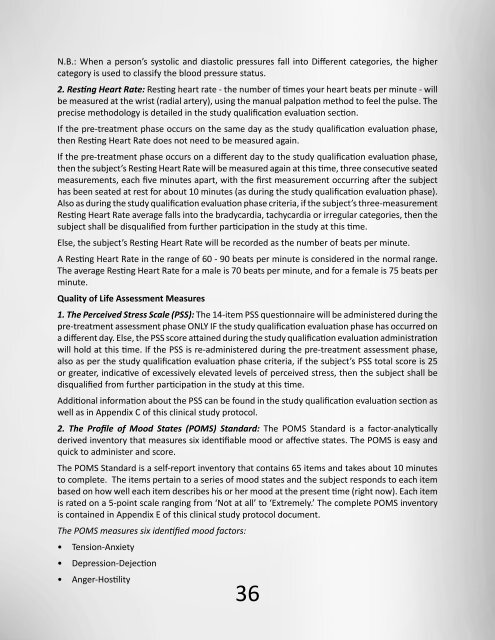Varhope charging the batteries
Varhope charging the batteries
Varhope charging the batteries
Create successful ePaper yourself
Turn your PDF publications into a flip-book with our unique Google optimized e-Paper software.
N.B.: When a person’s systolic and diastolic pressures fall into Different categories, <strong>the</strong> highercategory is used to classify <strong>the</strong> blood pressure status.2. Resting Heart Rate: Resting heart rate - <strong>the</strong> number of times your heart beats per minute - willbe measured at <strong>the</strong> wrist (radial artery), using <strong>the</strong> manual palpation method to feel <strong>the</strong> pulse. Theprecise methodology is detailed in <strong>the</strong> study qualification evaluation section.If <strong>the</strong> pre-treatment phase occurs on <strong>the</strong> same day as <strong>the</strong> study qualification evaluation phase,<strong>the</strong>n Resting Heart Rate does not need to be measured again.If <strong>the</strong> pre-treatment phase occurs on a different day to <strong>the</strong> study qualification evaluation phase,<strong>the</strong>n <strong>the</strong> subject’s Resting Heart Rate will be measured again at this time, three consecutive seatedmeasurements, each five minutes apart, with <strong>the</strong> first measurement occurring after <strong>the</strong> subjecthas been seated at rest for about 10 minutes (as during <strong>the</strong> study qualification evaluation phase).Also as during <strong>the</strong> study qualification evaluation phase criteria, if <strong>the</strong> subject’s three-measurementResting Heart Rate average falls into <strong>the</strong> bradycardia, tachycardia or irregular categories, <strong>the</strong>n <strong>the</strong>subject shall be disqualified from fur<strong>the</strong>r participation in <strong>the</strong> study at this time.Else, <strong>the</strong> subject’s Resting Heart Rate will be recorded as <strong>the</strong> number of beats per minute.A Resting Heart Rate in <strong>the</strong> range of 60 - 90 beats per minute is considered in <strong>the</strong> normal range.The average Resting Heart Rate for a male is 70 beats per minute, and for a female is 75 beats perminute.Quality of Life Assessment Measures1. The Perceived Stress Scale (PSS): The 14-item PSS questionnaire will be administered during <strong>the</strong>pre-treatment assessment phase ONLY IF <strong>the</strong> study qualification evaluation phase has occurred ona different day. Else, <strong>the</strong> PSS score attained during <strong>the</strong> study qualification evaluation administrationwill hold at this time. If <strong>the</strong> PSS is re-administered during <strong>the</strong> pre-treatment assessment phase,also as per <strong>the</strong> study qualification evaluation phase criteria, if <strong>the</strong> subject’s PSS total score is 25or greater, indicative of excessively elevated levels of perceived stress, <strong>the</strong>n <strong>the</strong> subject shall bedisqualified from fur<strong>the</strong>r participation in <strong>the</strong> study at this time.Additional information about <strong>the</strong> PSS can be found in <strong>the</strong> study qualification evaluation section aswell as in Appendix C of this clinical study protocol.2. The Profile of Mood States (POMS) Standard: The POMS Standard is a factor-analyticallyderived inventory that measures six identifiable mood or affective states. The POMS is easy andquick to administer and score.The POMS Standard is a self-report inventory that contains 65 items and takes about 10 minutesto complete. The items pertain to a series of mood states and <strong>the</strong> subject responds to each itembased on how well each item describes his or her mood at <strong>the</strong> present time (right now). Each itemis rated on a 5-point scale ranging from ‘Not at all’ to ‘Extremely.’ The complete POMS inventoryis contained in Appendix E of this clinical study protocol document.The POMS measures six identified mood factors:• Tension-Anxiety• Depression-Dejection• Anger-Hostility<strong>Varhope</strong><strong>charging</strong> <strong>the</strong> <strong>batteries</strong>• Vigor-Activity• Fatigue-Inertia• Confusion-BewildermentThe POMS Standard includes psychiatric norms derived from a sample of 100 individuals, collegestudent norms derived from 856 undergraduates, adult norms derived from a group of 400volunteers aged 18-94, stratified by age, gender and race according to <strong>the</strong> 1990 U.S. census.Since 1971, many research studies have provided evidence for <strong>the</strong> predictive and construct validityof <strong>the</strong> POMS Standard. Alpha coefficient and o<strong>the</strong>r studies have found <strong>the</strong> POMS Standard toexhibit a high satisfactory level of internal consistency, while product-moment correlations indicatea reasonable level of test-retest reliability. Factor analytic replications provide evidence of <strong>the</strong>factorial validity of <strong>the</strong> 6 mood factors, and an examination of <strong>the</strong> individual items defining eachmood state supporting <strong>the</strong> content validity of <strong>the</strong> factor scores. Many recent studies continue toadd to and affirm <strong>the</strong> validity of POMS normative sample. A bibliography of published research ofalmost 3000 research studies from 1964-2002 utilizing <strong>the</strong> POMS adds to and affirms <strong>the</strong> validityof <strong>the</strong> POMS normative sample and is available upon request.3. Spielberger’s State-Trait Anxiety Inventory (STAI): The State-Trait Anxiety Inventory (STAI)provides a reliable measure of both temporary and dispositional anxiety in adults. First developedby Charles D. Spielberger in <strong>the</strong> 1960s, <strong>the</strong> STAI was later revised in 1983. The revised STAI istypically referred to as <strong>the</strong> STAI-Y. The STAI is a self-administered test and it is <strong>the</strong> most widely usedmeasure of anxiety worldwide, used in both clinical and research settings. It is suitable for adultsat a 6th grade reading level or above.The STAI consists of 40 items divided into two subscales or domains: State Anxiety and TraitAnxiety:State Anxiety assesses an individual’s current level of anxiety – a more temporary state. The20 items measuring State Anxiety ask subjects how <strong>the</strong>y feel “right now, at this moment,” andreflects situational factors that may influence anxiety levels. Subjects rate <strong>the</strong>ir feelings abouteach statement on a four-point intensity scale of 1=Not at all, 2=Somewhat, 3=Moderately So, and4=Very Much So.Trait Anxiety assesses an individual’s anxiety proneness – a more general and long-standingquality of how an individual typically responds to stress. The 20 items measuring Trait Anxiety asksubjects how <strong>the</strong>y “generally” feel. Subjects rate <strong>the</strong>mselves on a four-point frequency scale of1=Almost Never, 2=Sometimes, 3=Moderately So, and 4=Very Much So). Examples of items TraitAnxiety scale items are “I feel at ease;” “I feel upset;” “I lack self-confidence.”Scoring: State and trait anxiety are scored separately. Each item is scored from 1-4, for a totalinventory score range of 20 to 80, where 20 equals ’not feeling like that at all (state anxiety)or ever (trait anxiety)’ and 80 equals ‘feeling like that very much (state anxiety) or always (traitanxiety).’ Essentially, <strong>the</strong> higher <strong>the</strong> score, <strong>the</strong> greater <strong>the</strong> level of anxiety.Both percentile ranks and standard (T) scores are available for male and female working adultsand stratified by age.36 37
















